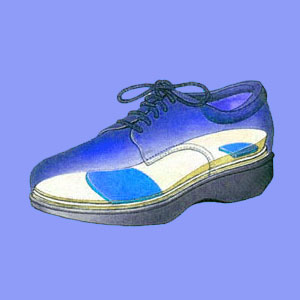
Sciatica shoes are specialized footwear or insoles used to relieve the burden of chronic back and leg suffering while standing, walking or exercising. These devices are extremely common and can certainly make physical activity more comfortable, especially when first applied. However, just like the plethora of other sciatica relief products, shoes and insoles are statistically unlikely to cure sciatica or even provide substantial relief in the long-term.
This dialog focuses on the use of shoes and insoles to actively treat sciatic nerve expressions.
Variety of Sciatica Shoes
There are sciatica treatment shoes in a great number of different styles. Medical manufacturers have created varieties appropriate for every occasion, from athletic shoes to business shoes to casual shoes. Most have certain specific pain relieving mechanisms or features built into the sole of the shoe, including pressure point reduction systems, gel inserts or built-up heels to even out short leg syndrome.
Most of these footwear devices are quite expensive and there is no doubt that the biggest beneficiary of these shoes is the manufacturer, due to high profit margins. Some shoes are even custom made and fitted by orthotic manufacturers.
Similarly, insoles can be purchased with these same features and can be added to any normal shoe for a more flexible pain prevention and management system.
Purpose of Sciatica Shoes
Specialized therapy shoes are often recommended by chiropractors, and orthotic makers, who just happen to sell them at a high profit margin. I have seen all manner of these devices recommended for various causative conditions and have yet to meet anyone who has enjoyed a lasting cure from their use.
Functional short leg syndrome is one of the most commonly treated diagnoses, but virtually anyone is likely to have one leg slightly shorter than the other at any given time. Chiropractors are really good at making this the focus of a diagnostic theory, leading to ongoing adjustments and worried patients who do not know the condition is normal and asymptomatic in 99% of cases.
Other people try sciatica relief shoes for sporting events, such as running. Although these may provide good support and some cushioning, they are certainly not going to prevent sciatica, since the source is not in the feet and may not even reside in the spine in some cases.
Sciatica Shoes Experiences
Orthotic shoes and insoles are typically placebo treatments used by desperate patients who will do anything, or buy anything, to find some semblance of relief. I can tell you from my own experience, as well as from the letters of tens of thousands of you out there reading, that shoes are not likely to be the answer for your pain.
What you need is an accurate diagnosis, which most of you just do not have. This explains why all the sciatica treatments you have tried failed so miserably. If you can achieve a correct diagnostic conclusion; you will be more than halfway to successful resolution of your pain. Until then, you are merely wandering and guessing.
My advice, buy shoes you like and save your money by skipping specialized back pain shoes. Of course, if you happen to like these ultra-fitted or padded styles, then so be it. The point is to buy good quality footwear based on your overall needs, instead of compromising on quality, style or overall usefulness simply to enjoy a theorized therapeutic effect, which may or may not even exist.





